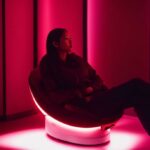Last Updated on 6 months by Francis
Are you struggling to get a good night’s sleep? You’re not alone. Many people have difficulty falling asleep or staying asleep, which can lead to a host of health problems and a decrease in overall well-being. Fortunately, there is a natural, non-invasive solution that can help improve your sleep quality: red light therapy.
Red light therapy is a form of photobiomodulation therapy that uses low-level red light wavelengths to stimulate cellular function in the body. By activating mitochondria, the energy-producing powerhouses of our cells, red light therapy has been shown to have numerous benefits for sleep quality, including improving insomnia, promoting deep sleep, regulating the circadian rhythm, and facilitating restful sleep.
In this comprehensive guide, we will explore how to effectively use red light therapy for better sleep. We’ll cover everything from what red light therapy is to how it benefits sleep, how to choose the right device, establishing an effective routine, and more. So, let’s dive in!
Contents
Key Takeaways:
- Red light therapy can improve sleep quality by promoting relaxation, regulating sleep hormones, and enhancing circulation.
- To choose the right red light therapy device, look for wavelengths between 630-660 nanometers and appropriate power output and coverage area.
- Establish a consistent red light therapy routine by using the device in the evening, creating a calming environment, and following the manufacturer’s instructions.
- Red light therapy can benefit individuals with insomnia by reducing anxiety and promoting relaxation.
- By increasing delta brainwaves, red light therapy can enhance deep sleep and aid in physical and mental restoration.
What is Red Light Therapy?
Red light therapy, also known as photobiomodulation therapy, is a non-invasive treatment that uses low-level red light wavelengths to stimulate cellular function. It works by penetrating the skin and activating mitochondria, the energy-producing powerhouses of our cells. This therapy has gained popularity for its various health benefits, including improving sleep.
Red light therapy uses light-emitting diodes (LEDs) to shine red light on the skin, which is absorbed by the cells and leads to various physiological effects. It is a painless and safe procedure that can be used on any part of the body. The red light used in this therapy has a wavelength between 630-660 nanometers, making it ideal for penetrating the skin and stimulating cellular function.
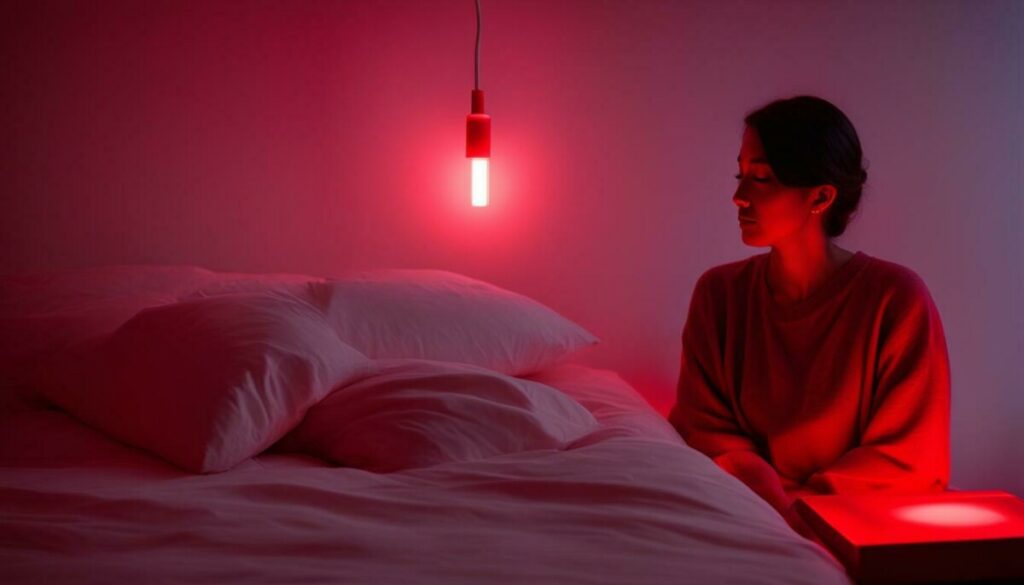
What is Red Light Therapy?
Red light therapy works by penetrating the skin and activating mitochondria, leading to various physiological effects that improve sleep and overall wellness.
How Does Red Light Therapy Benefit Sleep?
Red light therapy has been found to have numerous benefits for sleep quality. Let’s take a closer look at how it can help improve your sleep:
- Regulates melatonin production: Red light therapy can help regulate the production of melatonin, the hormone responsible for sleep-wake cycles. By increasing melatonin levels in the body, red light therapy promotes better sleep.
- Reduces cortisol levels: Red light therapy reduces levels of cortisol, the stress hormone, leading to relaxation and improved sleep.
- Enhances circulation: Red light therapy improves circulation, which can aid in achieving more restful sleep.
By addressing these underlying factors that may disrupt sleep, red light therapy can significantly improve overall sleep quality.

“Red light therapy has been found to positively impact sleep quality in several ways.”
Choosing the Right Red Light Therapy Device
Red light therapy devices come in various types, including handheld devices, light panels, and full-body devices. When selecting a device for sleep improvement, it’s crucial to consider a few factors to ensure optimal results.
Firstly, look for a device that emits wavelengths between 630-660 nanometers, as this range has been found to be the most effective for sleep-related benefits. Additionally, opt for a device with appropriate power output and coverage area to ensure optimal results.
Handheld devices are ideal for targeted therapy, such as treating a specific area of the body, while light panels can provide more comprehensive coverage. Full-body devices are the most convenient option, providing full-body coverage, but they are typically pricier.
It’s essential to choose a device that suits your needs and preferences, and also fits within your budget.
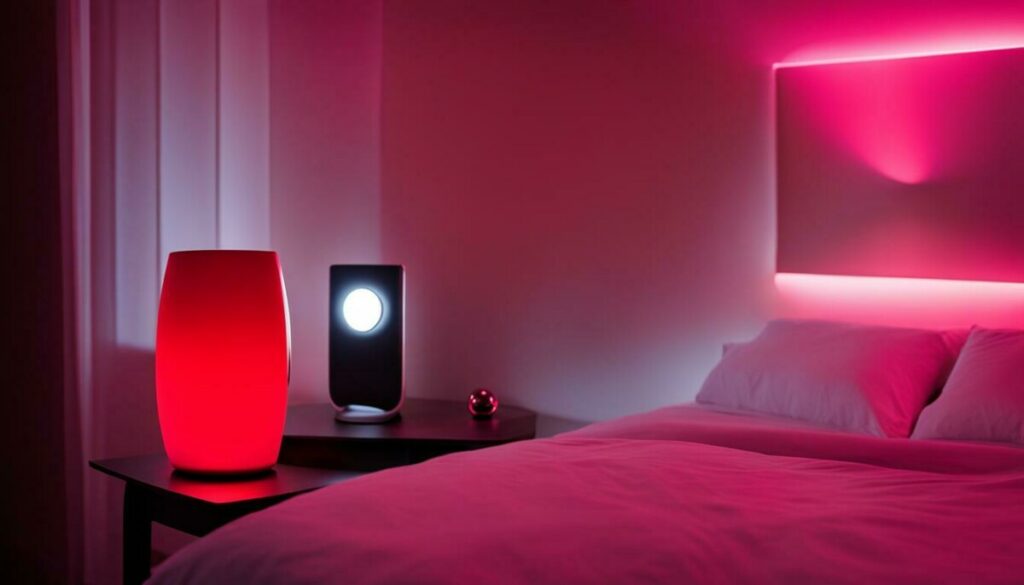
Some devices come with additional features, such as timers, automatic shut-off, and adjustable intensity settings. These can be useful for customizing your therapy session and ensuring safety.
Before purchasing a red light therapy device, be sure to do your research and read reviews from verified buyers. It can also be helpful to consult with a healthcare professional to determine if red light therapy is suitable for your specific needs.
Establishing an Effective Red Light Therapy Routine
To make the most of using red light therapy for better sleep, it’s important to establish a consistent routine. The timing of your red light therapy session can also play an important role in optimizing results. Most people find using red light therapy in the evening to be most effective, as it helps your body prepare for sleep.
Creating a calming environment is also essential when using red light therapy for better sleep. Try dimming any other lights and minimizing distractions to create a relaxing atmosphere.
The recommended session duration for red light therapy is typically 10-20 minutes, and the device should be placed approximately 6-12 inches away from your skin. Be sure to follow the manufacturer’s instructions for your specific device to ensure optimal results.

Using red light therapy for better sleep can be a great addition to your nighttime routine. By establishing a consistent routine, creating a calming environment, and following the recommended session duration and device placement, you can optimize the benefits of red light therapy for better sleep and wake up feeling rejuvenated.
Using Red Light Therapy for Insomnia
If you struggle with insomnia, red light therapy may be a viable treatment option for you. Insomnia is a sleep disorder affecting millions of people worldwide, characterized by difficulty initiating or maintaining sleep, resulting in daytime impairment.
Red light therapy has been found to be effective in treating insomnia by promoting relaxation and regulating sleep-wake cycles. It works by reducing anxiety and stress levels, which are often root causes of insomnia. Red light therapy also helps to increase the production of melatonin, the hormone responsible for promoting sleep.
If you’re considering red light therapy for insomnia, it’s crucial to use the therapy at the right time and with the correct frequency. It’s recommended to use red light therapy in the evening, preferably one to two hours before bed. Be consistent with the regimen, and avoid using the therapy during the day, as it may disrupt your natural sleep-wake cycle.
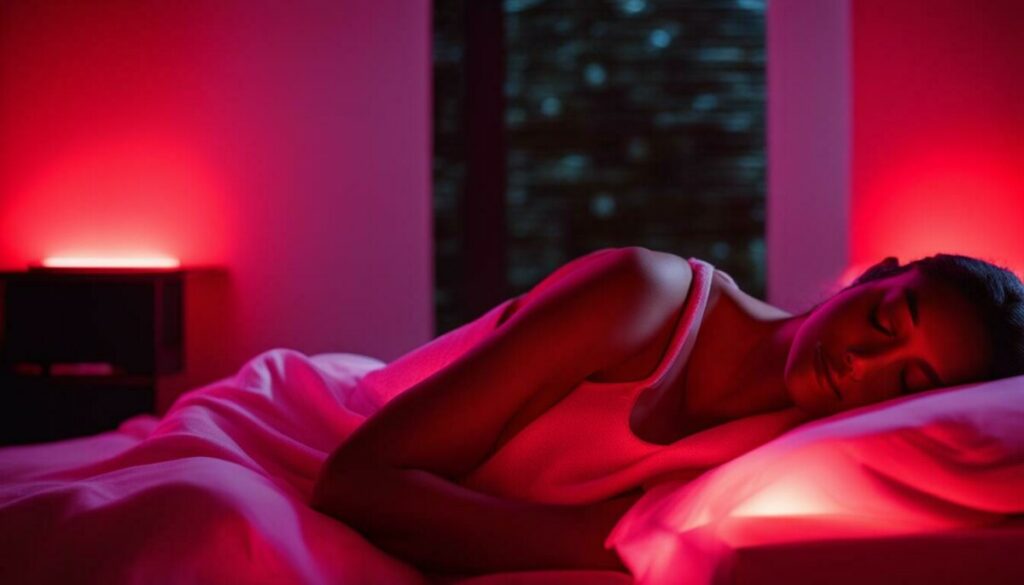
As with any therapy, red light therapy for insomnia should be used consistently for optimal results. The therapy usually takes several sessions before significant improvements can be seen. It’s essential to follow the manufacturer’s instructions and guidelines to ensure safe and effective use.
Red Light Therapy for Deep Sleep
Deep sleep is an essential stage of the sleep cycle that promotes physical and mental restoration. Red light therapy has been found to enhance deep sleep by increasing the production of delta brainwaves, which are associated with deep sleep states.
According to a study published in the Journal of Athletic Training, red light therapy increased the duration of total sleep time and deep sleep in collegiate football players. They received red light therapy for 30 minutes each day, five days a week, for four consecutive weeks. The results showed increased sleep duration and quality, along with improved mood and physical performance.
Another study published in Sleep Medicine found that red light therapy improved the sleep quality of patients with obstructive sleep apnea. The participants received red light therapy for 20 minutes per day over a period of two weeks. The results showed significant improvements in sleep quality and a reduction in symptoms of sleep apnea.
Incorporating red light therapy into your sleep routine can help you achieve deeper and more restful sleep. By increasing delta brainwave production, red light therapy promotes physical and mental restoration, leaving you feeling rejuvenated in the morning.
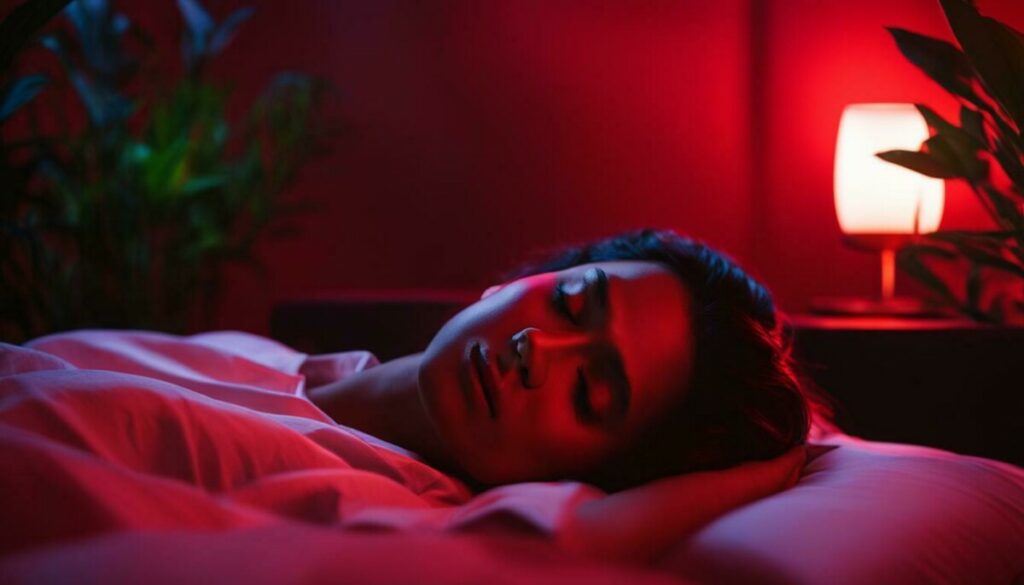
“Red light therapy was a game-changer for my sleep. I used to struggle with waking up feeling tired and groggy, but since incorporating red light therapy sessions into my evening routine, I’ve noticed a significant improvement in the quality of my sleep and how rested I feel in the morning.”
Red Light Therapy for Circadian Rhythm Regulation
Our bodies are designed to function in harmony with the natural cycles of day and night, known as the circadian rhythm. This internal clock regulates our sleep-wake cycles, hormone production, and other bodily functions. However, modern lifestyles and increased exposure to artificial light can disrupt the circadian rhythm, leading to sleep disturbances and other health issues.
Red light therapy can help to regulate the circadian rhythm and promote a more natural sleep-wake pattern. It works by stimulating the production of melanopsin, a photosensitive protein in the eye that is responsible for regulating the circadian rhythm. By using red light therapy in the morning or during the day, you can signal to your body that it’s time to be awake and active. Similarly, using red light therapy in the evening can promote relaxation and prepare your body for sleep.
Incorporating red light therapy into your daily routine can help to keep your circadian rhythm in sync and improve your overall sleep quality. By prioritizing regular exposure to natural light and using red light therapy as needed, you can support your body’s natural rhythms and achieve optimal health and wellbeing.
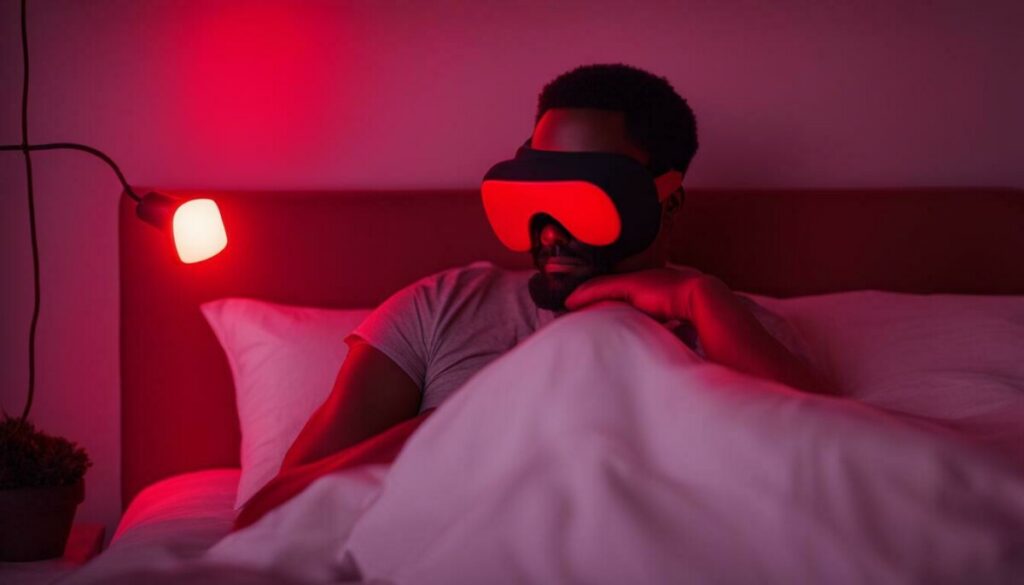
Enhancing Sleep Quality with Red Light Therapy
Red light therapy is a great tool for improving sleep quality by addressing underlying factors that may disrupt sleep. By reducing stress, promoting relaxation, and regulating sleep hormones, red light therapy can help you achieve more restful and rejuvenating sleep. It can also aid in reducing sleep disturbances, such as snoring or sleep apnea, by improving blood circulation and muscle recovery.
If you are looking to improve the quality of your sleep, incorporating red light therapy into your routine can be incredibly beneficial. Many people find that using red light therapy before bed helps them feel more relaxed and ready for sleep. With its ability to regulate melatonin production and balance the circadian rhythm, red light therapy can help you achieve a more natural and restful sleep pattern.
| Benefits of Red Light Therapy for Sleep Quality | How Red Light Therapy Helps |
|---|---|
| Improves relaxation and reduces stress levels | Reduces cortisol levels and stimulates production of endorphins |
| Promotes deeper, more restful sleep | Increases the production of delta brainwaves |
| Regulates the sleep-wake cycle | Regulates melatonin production and balances the circadian rhythm |
| Reduces sleep disturbances such as snoring or sleep apnea | Improves blood circulation and muscle recovery |
If you’re using red light therapy to improve sleep quality, it’s essential to establish a consistent routine and use it in conjunction with other healthy sleep habits. This can include creating a calming bedtime routine, minimizing exposure to blue light from electronic devices before bed, and ensuring your sleep environment is cool, dark, and quiet.
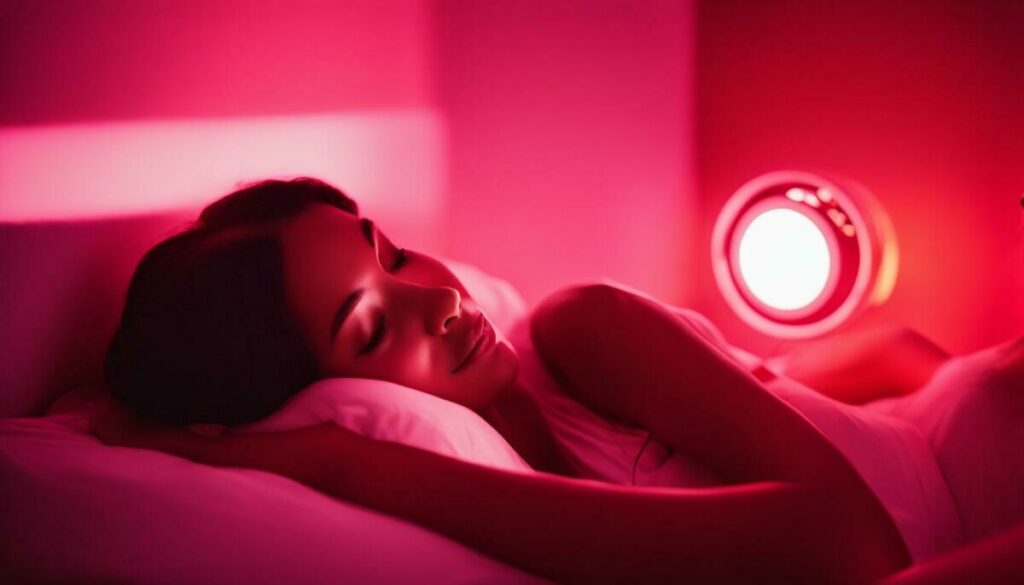
By incorporating red light therapy into your sleep routine and making other healthy lifestyle changes, you can significantly improve the quality of your sleep. Remember to monitor your sleep progress to determine if red light therapy is positively impacting your sleep. With consistent use and healthy sleep habits, you can achieve restful and rejuvenating sleep with the help of red light therapy.
Safety Precautions for Using Red Light Therapy for Sleep
While using red light therapy for better sleep is generally safe, there are some precautions you should take to ensure optimal results and minimize potential risks.
Firstly, avoid staring directly at the light source, as this can cause eye damage. If necessary, use appropriate eyewear to protect your eyes. Additionally, do not use red light therapy if you are taking photosensitizing medications or have an active skin condition.
Follow the recommended treatment duration and frequency specified by the manufacturer for your specific device. Overuse of red light therapy can potentially lead to skin irritation or other adverse effects.
If you have any pre-existing medical conditions or are taking medications, consult with a healthcare professional before starting red light therapy. They can advise you on whether it’s safe for you to use and provide any necessary precautions or recommendations.
By following these safety precautions, you can ensure a safe and effective experience using red light therapy for better sleep.
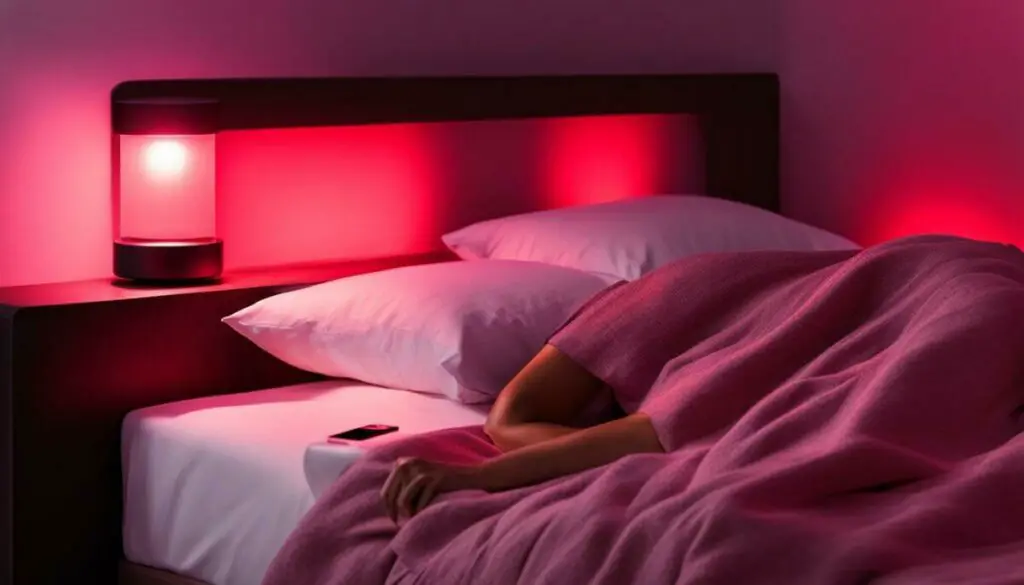
Other Considerations for Better Sleep
In addition to incorporating red light therapy into your sleep routine, there are several other factors to consider when aiming for better sleep. Here are some tips:
- Create a soothing bedtime routine: Establishing a calming bedtime routine can help signal to your body that it’s time to wind down and prepare for sleep. This could include reading a book, taking a warm bath, or practicing relaxation techniques like deep breathing.
- Maintain a consistent sleep schedule: Try to go to bed and wake up at the same time every day, even on weekends. This will help regulate your circadian rhythm and promote better sleep.
- Minimize exposure to blue light: The blue light emitted by electronic devices such as phones and laptops can interfere with the production of melatonin and disrupt sleep. Try to avoid using these devices for at least an hour before bed.
- Create a comfortable sleep environment: Ensure your sleep environment is cool, dark, and quiet. Use comfortable bedding and consider investing in a supportive mattress and pillows.
Remember, improving sleep quality is a multifaceted process that requires attention to several factors. By incorporating red light therapy into your routine and implementing healthy sleep habits, you can enjoy more restful and rejuvenating sleep.

Monitoring and Assessing Your Sleep Progress
As you incorporate red light therapy into your sleep routine, it’s important to track your progress to understand its effectiveness and make any necessary adjustments.
One way to monitor your sleep progress is by using sleep tracking devices or apps. These tools can provide valuable insights into your sleep patterns, including duration, quality, and any improvements you may notice. Some popular options include Fitbit, Sleep Cycle, and Oura Ring.
It’s also important to consider other factors that may impact your sleep quality, such as stress levels, diet, and exercise habits. Keep a journal to track any changes in these areas and how they may be influencing your sleep.
| Tip: | Consider using a combination of red light therapy and other sleep-promoting strategies, such as implementing a consistent sleep schedule, creating a calming bedtime routine, and reducing blue light exposure before bed. |
|---|
By regularly assessing your sleep progress, you can determine if red light therapy is positively impacting your sleep and make informed decisions regarding its continued use. Remember to consult with a healthcare professional if you have any pre-existing medical conditions or concerns.

Conclusion
Red light therapy is a promising solution for improving sleep quality, promoting relaxation, and regulating the circadian rhythm. By incorporating red light therapy into your sleep routine, you can experience numerous benefits, including deeper, more restful sleep, reduced stress, and improved overall wellness.
Take the First Step
If you’re ready to try red light therapy for better sleep, follow the steps outlined in this guide to choose the right device, establish a consistent routine, and monitor your sleep progress. Remember to consult with a healthcare professional if you have any pre-existing medical conditions or are taking medications.
Optimizing Your Sleep Environment
In addition to red light therapy, there are various other strategies you can implement to enhance your sleep environment. Consider maintaining a consistent sleep schedule, creating a soothing bedtime routine, minimizing exposure to blue light from electronic devices before bed, and ensuring your sleep environment is cool, dark, and quiet.
The Benefits of Better Sleep
With the help of red light therapy and other sleep-promoting strategies, you can achieve more restful and rejuvenating sleep. Improved sleep quality can lead to numerous benefits, including increased productivity, enhanced cognitive function, improved mood, and better overall health.
Start your journey towards better sleep today with the power of red light therapy.
FAQ
What is red light therapy?
Red light therapy, also known as photobiomodulation therapy, is a non-invasive treatment that uses low-level red light wavelengths to stimulate cellular function. It works by penetrating the skin and activating mitochondria, the energy-producing powerhouses of our cells.
How does red light therapy benefit sleep?
Red light therapy positively impacts sleep quality by regulating the production of melatonin, reducing levels of cortisol, and enhancing circulation, all of which contribute to better sleep.
How do I choose the right red light therapy device?
When selecting a red light therapy device, look for wavelengths between 630-660 nanometers and consider the power output and coverage area. There are various types of devices available, such as handheld devices, light panels, and full-body devices.
What is an effective red light therapy routine for better sleep?
Establish a consistent routine by using red light therapy in the evening, creating a calming environment, and following the manufacturer’s instructions for session duration and device placement.
Can red light therapy help with insomnia?
Yes, red light therapy has shown promise in alleviating symptoms of insomnia by promoting relaxation, reducing anxiety, and regulating sleep-wake cycles.
How does red light therapy contribute to deep sleep?
Red light therapy enhances deep sleep by increasing the production of delta brainwaves, which are associated with deep sleep states. This can lead to longer and more rejuvenating periods of deep sleep.
Does red light therapy help regulate the circadian rhythm?
Yes, red light therapy can help align and regulate the circadian rhythm by signaling to the body when it’s time to be awake or preparing it for sleep.
How does red light therapy enhance sleep quality?
Red light therapy improves sleep quality by reducing stress, promoting relaxation, regulating sleep hormones, and aiding in reducing sleep disturbances.
Are there any safety precautions for using red light therapy for sleep?
While red light therapy is generally safe, it’s important to avoid staring directly at the light source, protect your eyes if necessary, and follow the recommended treatment duration and frequency. Consult with a healthcare professional if you have pre-existing medical conditions or are taking medications.
What other considerations can improve sleep quality?
In addition to red light therapy, maintaining a consistent sleep schedule, creating a soothing bedtime routine, minimizing exposure to blue light before bed, and ensuring a cool, dark, and quiet sleep environment can all contribute to better sleep.
How can I monitor and assess my sleep progress?
You can track your sleep progress using sleep tracking devices or apps, which can provide insights into sleep duration, quality, and improvements over time. Regularly assessing your sleep progress will help you understand the effectiveness of red light therapy.





